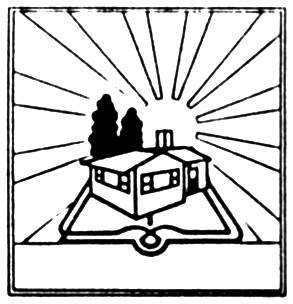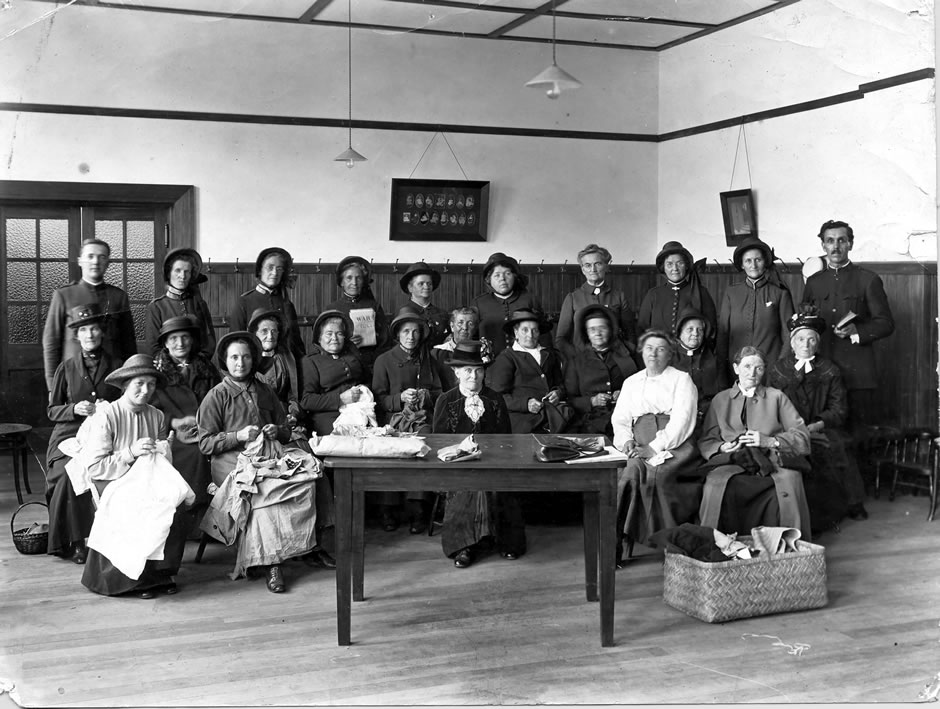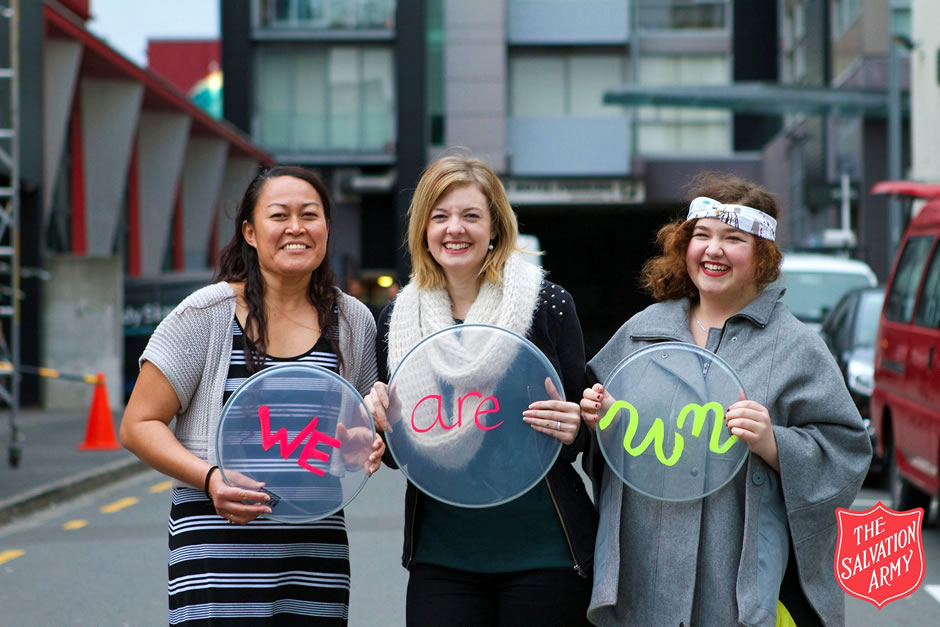
Salvation Army Women’s Ministries
1911 –
Theme: Religion
Known as:
- Salvation Army Home League
1911 – 1997 - Salvation Army Women’s Ministries
1997 –
This essay written by Laurence Hay was first published in Women Together: a History of Women's Organisations in New Zealand in 1993. It was updated by Shar Davis in 2018.
1911 – 1993
The Salvation Army Home League (SAHL) was the brain child of Florence Booth, daughter-in-law of the Army's founder, who perceived a need for practical and religious instruction for women of the 'lower classes'. Instructing members and service to non-members were closely related from the beginning, though the emphasis shifted over time.
The first Home League meeting was held in London in 1907. By an order from territorial headquarters in Melbourne, the league was inaugurated throughout Australasia in March 1911, 'to consider and give counsel [to married women] about the many problems connected with the home and family – whether a question of management, or of hygienic, moral, or spiritual significance'. Those who were 'not definitely converted' were to be encouraged to attend, and could be made members when converted. [1]
The North Dunedin Corps was already holding weekday meetings for married women; it applied the new name to these meetings to form the first New Zealand league. Other leagues were formed in Invercargill, Gisborne, Ashhurst and Napier in 1911, but there was little general enthusiasm. A new start was made in 1916, when on Easter Saturday Commissioner Henry Hodder inaugurated leagues at Auckland City, Eden and Onehunga corps. At about the same time the league was launched at Wellington City Corps, and by the end of 1916 at least seventeen local leagues were active in New Zealand. Their purpose was 'giving spiritual counsel and practical direction to women in all matters relating to the Home'. [2]
The 1916 regulations relaxed the policy on membership: it was to be open to any woman of the district over eighteen (later fifteen) years of age, 'whether married or single, saved or unsaved' – though the majority were usually Salvationist. [3] A woman Salvation Army soldier was to be commissioned as secretary. A pattern for a typical weekly meeting was provided, including singing and prayers, a 'cup of tea (with biscuit)', and an address, reading or spiritual talk to conclude. Mending, knitting and sewing were to be permitted during meetings.
Much of the enthusiasm for the revived league, and much of its energy, arose from the urge to provide 'comforts' for New Zealand soldiers overseas. When World War I ended, this zeal for service was redirected toward the poor and needy at home. The fundamental aim of the league, however, was evangelical and spiritual, carried out mainly through the weekly meetings and personal visiting.
In the twenty years between the wars the league saw unprecedented growth, from eighteen branches with nearly 500 members in 1919 to 103 branches with 3429 members in 1938. In 1937 alone, a three-month extension campaign brought in 500 new members. In about 1940, the purposes of the league were succinctly summarised as worship, education, fellowship and service; this fourfold aim provided a sharpened focus for league activities.

Salvation Army Archives.
Members of the Wellington City Home League and male corps officers, 1921.
During World War II New Zealand home leaguers again supplied 'comforts' for soldiers, and clothes for refugees in England. Membership was maintained at around 3200, though average attendances slipped. In 1938 the Australian league introduced the 'outer circle', allowing women who lived too far away to attend meetings to enrol and receive a monthly letter of news and encouragement. Introduced here in 1940, by 1949 the outer circle had a membership of 349; by the late 1960s it was over 700, but in 1991 was back to 340.
Another innovation with long-term consequences for the movement was the home league auxiliary meeting. These began in England in the early 1940s as an adaptation to wartime conditions, and were intended for younger women unable to attend the usual daytime meeting. The first auxiliary in New Zealand began at Wellington City Corps in 1948. Such groups, called home league fellowships from 1971, numbered 52 by 1981 and became a common feature of New Zealand corps life; they usually met monthly in the evening.
After 1945, in contrast to the inter-war years, the leagues moved their service focus to the needy overseas, sending large quantities of food and clothing to England and to New Zealand Salvationist missionaries. Over time, however, the emphasis shifted from providing goods to raising funds. By 1990 the home leagues were raising over $100,000 annually for local and overseas needs. However, the focus of membership continued to be the weekly league meeting with its traditional format, its cup of tea and its friendliness. This programme of activities from the 1950s would be recognised by many in 1993 as still typical of the league: a factory visit, a Health Department film afternoon, a talk on plant life by a local nurseryman, a demonstration of Māori arts and crafts, and a grandmothers' afternoon.
The administrative structure of the league mirrored that of the Salvation Army at large. Internationally, direction was given by the London-based General (in 1993, Eva Burrows) through the issuing of orders and regulations. All league positions were filled by appointment, with final authority for the New Zealand league resting with territorial headquarters in Wellington. The territorial home league secretary supervised the five divisional secretaries, who in turn oversaw the local leagues. In practice, this highly-centralised structure was tempered by the large degree of freedom allowed to local league leaders, consultation fostered by frequent national and regional gatherings, and visits to local branches by territorial and divisional leaders. Home League Highlights, published from 1948, also encouraged local initiative.
Membership grew steadily from 1940, though more slowly after the 1960s, when it reached 4000 (excluding the outer circle); in 1993 it stood at almost 4900. Growth was strongest in the evening fellowships until the late 1980s, when there was dramatic growth in the new special interest women's groups – for example on budgeting, parenting, craft, drama, prayer and Bible study. Such groups came under the umbrella of the home league, but were often short-term and did not require the commitment of long-term membership that the league depended on in the past. They were hailed as a return to meeting needs 'which brought about the formation of the Home League in the first place'. [4] But the overarching spiritual purpose of the league, symbolised by its logo – the home on the open Bible – remained constant.
Laurence Hay
1994 – 2018
For much of the twentieth century, ‘women’s ministries’ in The Salvation Army had meant the Home League. This pattern changed significantly after 1993. As these groups declined in numbers with aging membership, their comparatively narrow sphere of ministry was open to question in the diverse and changing culture of New Zealand society.
In 1997, the appointment of Colonel June Kendrew as Territorial Women’s Ministry Secretary For New Zealand was an international first. It signalled that the Army leadership were serious about making programmes relevant, and gave permission for diversity, including trial or short-term programmes. A change of name to Salvation Army Women’s Ministries took place that year. Facilitating change, the Home League Highlights resource material was renamed Inter-Islander to provide information, ideas and resources that would spark new thinking and promote new programmes locally. As the First Step Ministry replaced Cradle Roll, attractive resources were provided for parents of children attending Salvation Army preschool programmes. Among other changes was a move to day or weekend Bible-based conventions for women.
The first ever Territorial Women’s Bible Conference, ‘Get Away with the Word’, in November 2001 saw 600 women meet in Waikanae. This event proved to be significant and spiritually empowering. In 2005 Major Glenda Bezzant created the first of five annual Women of the World (WOW) conferences out of Napier Corps. Others began to catch the vision for hosting conferences, and all around New Zealand, similar conferences were organised by local corps. In 2013, after being confronted about the extreme oppression faced by women around the world, Captain Sammy Millar created the ‘Her Freedom Song’ conference to challenge those injustices, raise awareness and spur people to action. During three conferences over five years, women were equipped to be agents of change in their own communities, and raised thousands of dollars to assist overseas work supporting the liberation and empowerment of girls and women.
Women’s Ministries demonstrated a wide world-embracing vision, with fundraising projects remaining an important focus: between 1983 and 2008, women raised over two million dollars through sales tables, weekly donations and other fundraising efforts. The ‘Cherish a Child’ sponsorship scheme had commenced in 1991 and within months saw 100 children being sponsored in six countries. After the shift from sponsoring an individual child to a centre-based support, by 2018 ‘Child Sponsorship’ was supporting over 840 children and their families, in 293 Salvation Army centres spread over 22 countries.

Salvation Army
The launch of WM, the 2016 rebranding of the Women's Ministries aimed at engaging younger women.
Women’s Ministries underwent a rebrand in 2016, and began using social media as a platform to engage younger women in the Women’s Ministries space. Under the brand ‘WM’, its purpose was to engage women, empower mission and ignite action. The creation of resources and campaigns, such as Mother’s Day—‘She Embodies’, and Women’s Suffrage celebrations—‘Our Women Preach’, as well as ’45 Ways to Encounter God’ prayer resources in English and Māori, were particularly successful. The ‘Put That on Your Resumé’ video, featuring Salvationists reciting Valerie Kiesser Geer’s poem, celebrated the leadership and initiative of women. The video—viewed over 37,000 times around the world—illustrated that Women’s Ministries within The Salvation Army had a growing audience and influence, no longer limited to the local weekly Home League gathering.
Shar Davis
Notes
[1] The War Cry, 11 March 1911, p. 5.
[2] Orders and Regulations for The Home League, July 1916.
[3] Orders and Regulations for The Home League, July 1916.
[4] Territorial Commander's report, 1991, p. 26.
Unpublished sources
Chief secretary's statistics book, 1914–1978, Salvation Army Territorial Headquarters, Wellington
Salvation Army Territorial Home League Department records, 1960–1991, Salvation Army Territorial Headquarters, Wellington
Salvation Army Women’s Ministries Facebook page: https://www.facebook.com/SalvationArmy.WM/
Published sources
Bradwell, Cyril, Fight the Good Fight: The Story of the Salvation Army in New Zealand 1883–1983, Reed, Wellington, 1982
Fifty Years of Home-building: The Home League 1907–1957, Salvationist Publishing and Supplies, London, 1957
Home League Highlights, 1948–1992
Moon, Gladys, 'Home League Half Century', in The Salvation Army Year Book, Salvationist Publishing and Supplies, London, 1957, pp. 16–18
The Salvation Army, Orders and Regulations for the Home League, International Headquarters, London, 1916, 1928, 1946, 1953, 1960, 1962, 1971, 1976, 1986
The Salvation Army (NZ), Annual Report 2017–2018: The Salvation Army New Zealand, Fiji, Tonga and Samoa, Wellington, 2018
The Salvation Army (NZ), Many Voices in Mission: 25 Years of The Salvation Army in New Zealand, Fiji and Tonga, Flag Publications, Wellington, 2008
The Salvation Army (NZ), The Home League and Associated Activities: Manual of Guidance for Officers and Leaders, New Zealand and Fiji Territory, Salvation Army, Wellington, 1989
War Cry (New Zealand edn), 1883–2018

Community contributions